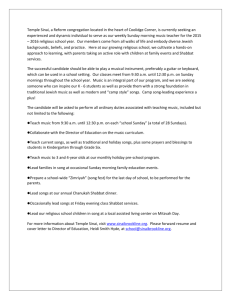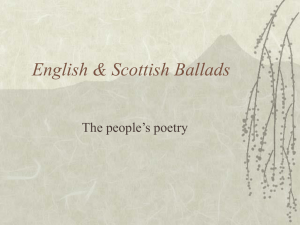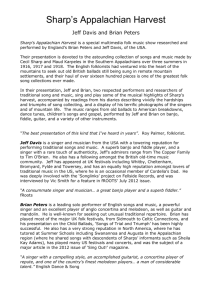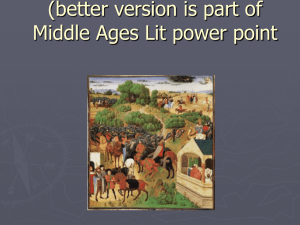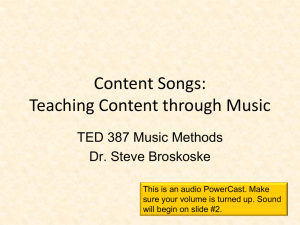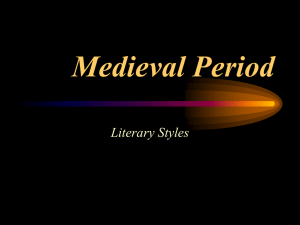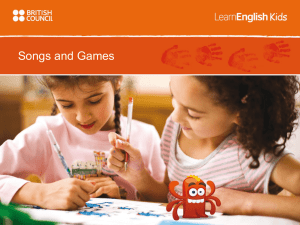Scots Song Workshop Topics
advertisement
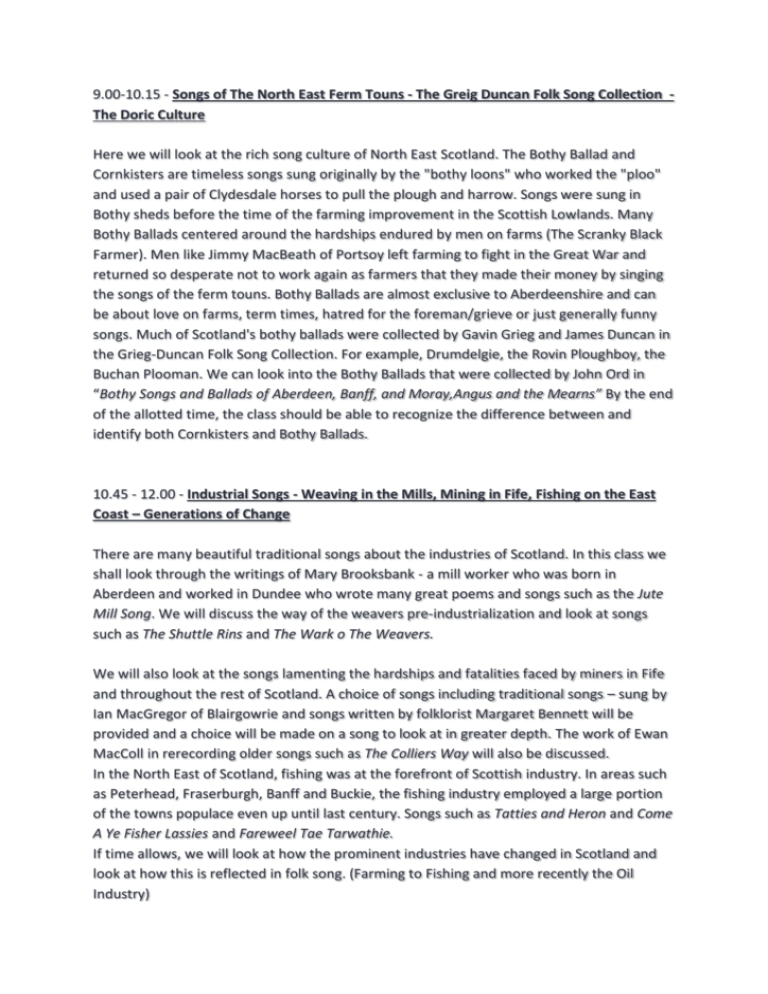
9.00-10.15 - Songs of The North East Ferm Touns - The Greig Duncan Folk Song Collection The Doric Culture Here we will look at the rich song culture of North East Scotland. The Bothy Ballad and Cornkisters are timeless songs sung originally by the "bothy loons" who worked the "ploo" and used a pair of Clydesdale horses to pull the plough and harrow. Songs were sung in Bothy sheds before the time of the farming improvement in the Scottish Lowlands. Many Bothy Ballads centered around the hardships endured by men on farms (The Scranky Black Farmer). Men like Jimmy MacBeath of Portsoy left farming to fight in the Great War and returned so desperate not to work again as farmers that they made their money by singing the songs of the ferm touns. Bothy Ballads are almost exclusive to Aberdeenshire and can be about love on farms, term times, hatred for the foreman/grieve or just generally funny songs. Much of Scotland's bothy ballads were collected by Gavin Grieg and James Duncan in the Grieg-Duncan Folk Song Collection. For example, Drumdelgie, the Rovin Ploughboy, the Buchan Plooman. We can look into the Bothy Ballads that were collected by John Ord in “Bothy Songs and Ballads of Aberdeen, Banff, and Moray,Angus and the Mearns” By the end of the allotted time, the class should be able to recognize the difference between and identify both Cornkisters and Bothy Ballads. 10.45 - 12.00 - Industrial Songs - Weaving in the Mills, Mining in Fife, Fishing on the East Coast – Generations of Change There are many beautiful traditional songs about the industries of Scotland. In this class we shall look through the writings of Mary Brooksbank - a mill worker who was born in Aberdeen and worked in Dundee who wrote many great poems and songs such as the Jute Mill Song. We will discuss the way of the weavers pre-industrialization and look at songs such as The Shuttle Rins and The Wark o The Weavers. We will also look at the songs lamenting the hardships and fatalities faced by miners in Fife and throughout the rest of Scotland. A choice of songs including traditional songs – sung by Ian MacGregor of Blairgowrie and songs written by folklorist Margaret Bennett will be provided and a choice will be made on a song to look at in greater depth. The work of Ewan MacColl in rerecording older songs such as The Colliers Way will also be discussed. In the North East of Scotland, fishing was at the forefront of Scottish industry. In areas such as Peterhead, Fraserburgh, Banff and Buckie, the fishing industry employed a large portion of the towns populace even up until last century. Songs such as Tatties and Heron and Come A Ye Fisher Lassies and Fareweel Tae Tarwathie. If time allows, we will look at how the prominent industries have changed in Scotland and look at how this is reflected in folk song. (Farming to Fishing and more recently the Oil Industry) 1.15-2.15 - Child Ballads and Murder Ballads Francis James Child was an American born folklorist - he collected folk songs and created what is known as the Child Ballads – not to be confused as a collection of ballads for children. The Child Ballads consist of five volumes which were published between 1882 and 1898. Many songs in the Child Collection such as the Dowie Dens of Yarrow, are murder ballads and the two are almost synonymous with one another. We should look through at least one song from each volume of the collection and decide to look at one song in more depth. Murder Ballads are very common in British Balladry and tend to be long in length. Songs such as The Cruel Mither, The Twa Sisters or Lord Randall are very common on the Scottish Song circuit and tend to have multiple versions. If time allows, we can look at the variations of murder ballads. Many of the Child Ballads have death or murder as a theme – for example, The Flooer o’ Northumberland. We will successfully identify the cross-over and link between many Murder Ballads and Child Ballads. 2.30 - 3.45 – Songs of the Travelling People The Scottish Travelling Families such as the Stewarts of Blair (Sheila Stewart) and Fetterangus (Elizabeth Stewart) proved to be fundamental to the folk revival in Britain. We will look at the songs sung by travelling people such as Jeannie Robertson and her daughter Lizzie Higgins. Both finally residing more permanently in Aberdeen, Jeannie Robertson recorded and sung songs which would have perhaps otherwise been lost such as Bonny Udny and The Battle of Harlaw. We will look at the lives of travelers – berry picking in the summer and hawking items to make their “doss” and their consequent unfortunate persecution. Songs such as The Berryfeilds of Blair and Yellow on the Broom are successful in encapsulating and describing the lives of the travelling people. 4.00-5.15 – Border Ballads and the work of Sir Walter Scott Border Ballads were collected in the English/Scottish border region. Just as bothy ballads or classic ballads are sung, border ballads are also sung unaccompanied. But in recent years, with accompaniment in bands (Malinky). The book Minstrelsy of the Scottish Border was first published around 1802/3 and was compiled by Sir Walter Scott. Scott was the Sheriff of Selkirkshire and often fitted his collecting of songs in whilst travelling. The collection was made possible also by the contribution of other ballad collectors such as Robert Jamieson, George Ellis, John Layden and Robert Surtees. This collection also includes some songs which feature in the Child collection. “The Borders is not a line but an area, in many respects historically and traditionally almost an independent region, certainly so in the eyes of the inhabitants who gave us the Ballads”1. Another significant collector of border ballads was James Hogg, who was born in Ettrick in the Borders and nicknamed the “Ettrick Shepherd”. We may look at songs directly relate to place names in the borders such as Fair Helen of Kirkconnel and The Lament of the Border Widow and we may look at songs which are mainly known for being in the collections of James Hogg or Sir Walter Scott. Much of the Border Ballads date back to the 15th and 16th Centuries and are deemed as ancient. We may look at contemporary interpretations of these songs and look at ways of arranging ballads in both a very traditional sense but in a more modern way also. Other topics that I would be interested in teaching are listed below: Vocal Techniques of Folk Singing - Ornamentation during song - Breathing techniques - Accents and the pronunciation of words commonly found in folksong Performance and Stagecraft - Introductions to Songs - Tackling stage fright and anxiety - Energy Levels - Pre-performance practices Technique and Healthy Practice Together we will discuss briefly how to look after your voice to ensure the highest standards of performance possible. We will look at retraction of the voice, posture, breaks in the voice and ranged.We will discuss the best ways to maintain voice quality – steaming, water consumption, crystals. We will look at scales and practices which will strengthen the voice. Songs of Robert Burns Robert Burns was born in Alloway and is Scotland’s national bard. His lyrics and poems were written in either Scots or in English. His works are timeless and have been sung and recorded by traditional singers and even “pop” singers for many years. Robert Burns has became synonymous with the song “Auld Lang Syne” which is sung worldwide at New Years but much of his earlier work often goes unrecognized. We will look at songs from the Kilmarnock Edition, first published on the 31st of July 1786 such as To A Mouse as well as some of Burn’s later work such as Westlin Winds and Of A The Airts. The Songs of Hamish Henderson Hamish Henderson is one of the most significant contributors to the 60’s British Folk Revival. His work collecting songs, writing and archiving for the School of Scottish Studies in Edinburgh places him as one of Scotland’s most valued men. Working with American Alan Lomax, Hamish “discovered” and recorded many of the significant folk singers of last century including Jimmy MacBeath, Jeannie Robertson, Lizzie Higgins and Sheila Stewart. His field work truly made an impact on Scots Traditional song and his own songs are sung often throughout various countries. We will look at Freedom Come All Ye as well as songs that are not so well known such as The 51st Highland Divisions Farewell to Sicily. Overall, I hope to teach various regional styles to contribute to a greater understanding of Traditional Scots Song and to provide a more holistic approach to the various areas of Scotland and their individual customs and cultures.
